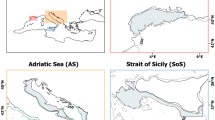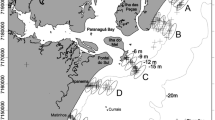Abstract
Salinities occupied by different life stages of bay anchovy (Anchoa mitchilli) were compared over annual cycles at 128 stations in 12 Florida estuaries. The comparison included eight stations in an oligotrophic, groundwater-based estuary in which all life stages were rare or absent. At other stations, adults, eggs, and early larvae occurred in intermediate to high salinities (10-30 psu) with no apparent central salinity tendency. The larva-juvenile transition was marked by an upstream shift to lower salinities (0-15 psu), also with no central salinity tendency. Mean salinities of the juvenile catch were strongly dependent on the salinities of the sampling effort. This dependence was strongest in estuaries that had weak horizontal salinity gradients. Weak salinity gradients were either natural or resulted from estuarine dams. After using nonlinear regression to account for the interaction between effort salinity and catch salinity, catch salinities were found to be similar from year to year within estuaries, but widely different among estuaries, with interestuarine differences ranging as high as 10–13 psu. Lower salinities were occupied by juveniles in estuaries that had long freshwater turnover times. Inherent geomorphic and inflow-related effects on the distribution of prey resources, coupled with an ontogenetic diet shift, are proposed as the explanation for both the habitat shift and the strong interestuarine variability in salinity at capture.
Similar content being viewed by others
Literature Cited
Able, K. W. 2005. A re-examination offish estuarine dependence: Evidence for connectivity between estuarine and ocean habitats.Estuarine, Coastal and Shelf Science 64:5–17.
Beck, M. W., K. L. Heck, Jr.,K. W. Able, D. L. Childers, D. B. Eggleston, B. M. Gillanders, B. Halpern, C. G. Hays, K. Hoshino, T. J. Minello, R. J. Orth, P. F. Sheridan, andM. P. Weinstein. 2001. The identification, conservation, and management of estuarine and marine nurseries for fish and invertebrates.BioScience 51:633–641.
Callahan, J., M. Dai, R. F. Chen, X. Li, Z. Lu, andW. Huang. 2004. Distribution of dissolved organic matter in the Pearl River estuary, China.Marine Chemistry 89:211–224.
Colton, J. B., K. A. Honey, andR. F. Temple. 1961. The effectiveness of sampling methods used to study the distribution of larval herring in the Gulf of Maine.Journal du Conseil 26:180–190.
Dahlgren, C. P. andD. B. Eggleston. 2000. Ecological processes underlying habitat shifts in a coral reef fish.Ecology 81:2227–2240.
Dahlgren, C. P., G. T. Kellison, A. J. Adams, B. M. Gillanders, M. S. Kendall, C. A. Layman, J. A. Ley, I. Nagelkerken, andJ. E. Serafy. 2006. Marine nurseries and effective habitats: Concepts and applications.Marine Ecology Progress Series 312:291–295.
Dovel, W. L. 1981. Ichthyoplankton of the lower Hudson River, New York.New York Fish and Game Journal 28:21–39.
Dye, A. H. 2006. Is geomorphic zonation a useful predictor of patterns of benthic infauna in intermittent estuaries in New South Wales, Australia?Estuaries and Coasts 29:455–464.
Estevez, E. D., L. K. Dixon, andM. S. Flannery. 1991. West-coastal rivers of peninsular Florida, p. 187–221.In R. J. Livingston (ed.), Rivers of Florida. Ecological Studies No. 83. Springer-Verlag, New York.
Flannery, M. S., E. B. Peebles, andR. T. Montgomery. 2002. A percent-of-flow approach for managing reductions of freshwater inflows from unimpounded rivers to southwest Florida estuaries.Estuaries 25:1318–1332.
Fore, P. L. andK. N. Baxter. 1972. Diel fluctuations in the catch of larval gulf menhaden,Brevoortia patronus, at Galveston entrance, Texas.Transactions of the American Fisheries Society 101:729–732.
Greenwood, M. F. D., R. E. Matheson, Jr.,R H. McMichael, Jr., andT. C. MacDonald. 2007. Community structure of shoreline nekton in the estuarine portion of the Alafia River, Florida: Differences along a salinity gradient and inflow-related changes.Estuarine, Coastal and Shelf Science 74:223–238.
Harris, P. T. andA. D. Heap. 2007. Comment on “Is geomorphic zonation a useful predictor of patterns of benthic infauna in intermittent estuaries in New South Wales, Australia?” by A. H. Dye.Estuaries and Coasts 30:562–566.
Harrison, T. D. andA. K. Whitfield. 2006. Estuarine typology and the structuring of fish communities in South Africa.Environmental Biology of Fishes 75:269–293.
Hartman, K. J., J. Howell, andJ. A. Sweka. 2004. Diet and daily ration of bay anchovy in the Hudson River, New York.Transactions of the American Fisheries Society 133:762–771.
Hood, R. R., H. V. Wang, J. E. Purcell, E. D. Houde, andL. W. Harding, Jr. 1999. Modeling particles and pelagic organisms in Chesapeake Bay: Convergent features control plankton distributions.Journal of Geophysical Research 104:1223–1243.
Houde, E. D. andJ. A. Lovdal. 1984. Seasonality of occurrence, foods and food preferences of ichthyoplankton in Biscayne Bay, Florida.Estuarine, Coastal and Shelf Science 18:403–419.
Kimmel, D. G., W. D. Miller, andM. R. Roman. 2006. Regional scale climate forcing of zooplankton dynamics in Chesapeake Bay.Estuaries and Coasts 29:375–387.
Kimura, R., D. H. Secor, E. D. Houde, andP. M. Piccoli. 2000. Up-estuary dispersal of young-of-the-year bay anchovyAnchoa mitchilli in the Chesapeake Bay: Inferences from microprobe analysis of strontium in otoliths.Marine Ecology Progress Series 208:217–227.
King, B. D. 1971. Study of migratory patterns of fish and shellfish through a natural pass.Texas Parks and Wildlife Department Technical Series 9:1–54.
Lapolla, A. E. 2001. Bay anchovyAnchoa mitchilli in Narragansett Bay, Rhode Island. II. Spawning season, hatch-date distribution and young-of-the-year growth.Marine Ecology Progress Series 217:103–109.
Li, H. andG. S. Maddala. 1999. Bootstrap variance estimation of nonlinear functions of parameters: An application to long-run elasticities of energy demand.Review of Economics and Statistics 81:728–733.
Luo, J. andJ. A. Musick. 1991. Reproductive biology of the bay anchovy in Chesapeake Bay.Transactions of the American Fisheries Society 120:701–710.
Lyczkowski-Shultz, J. andJ. P. J. Steen. 1991. Diel vertical distribution of red drumSciaenops ocellatus larvae in the north central Gulf of Mexico.Fishery Bulletin 89:631–641.
MacGregor, J. M. andE. D. Houde. 1996. Onshore-offshore pattern and variability in distribution and abundance of bay anchovyAnchoa mitchilli eggs and larvae in Chesapeake Bay.Marine Ecology Progress Series 138:15–25.
North, E. W. andE. D. Houde. 2004. Distribution and transport of bay anchovy (Anchoa mitchilli) eggs and larvae in Chesapeake Bay.Estuarine Coastal Shelf Science 60:409–429.
Olney, J. E. 1983. Eggs and early larvae of the bay anchovy,Anchoa mitchilli, and the weakfish,Cynoscion regalis, in lower Chesapeake Bay with notes on associated ichthyoplankton.Estuaries 6:20–25.
Paerl, H. W., L. M. Valdez, B. L. Peierls, J. E. Adolf, andL. W. Harding. 2006. Anthropogenic and climatic influences on the eutrophication of large estuarine ecosystems.Limnology and Oceanography 51:448–462.
Peebles, E. B. 2002a. Temporal resolution of biological and physical influences on bay anchovyAnchoa mitchilli egg abundance near a river-plume frontal zone.Marine Ecology Progress Series 237:257–269.
Peebles, E. B. 2002b. An assessment of the effects of freshwater inflows on fish and invertebrate habitat use in the Alafia River estuary. Report prepared by the University of South Florida College of Marine Science for the Southwest Florida Water Management District, Brooksville, Florida.
Peebles, E. B. 2005. An analysis of freshwater inflow effects on the early stages of fish and their invertebrate prey in the Alafia River estuary. Report prepared by the University of South Florida College of Marine Science for the Southwest Florida Water Management District, Brooksville, Florida.
Peebles, E. B., M. S. Flannery, R. E. Matheson, Jr., andJ. P. Rast. 1991. Fish nursery utilization of the Little Manatee River estuary: Relationships to physicochemical gradients and the distribution of food resources, p. 341–368.In S. F. Treat and P. A. Clark (eds.), Proceedings, Tampa Bay Area Scientific Information Symposium 2, Tampa Bay Regional Planning Council, Tampa, Florida.
Peebles, E. B., J. R. Hall, andS. G. Tolley. 1996. Egg production by the bay anchovyAnchoa mitchilli in relation to adult and larval prey fields.Marine Ecology Progress Series 131:61–73.
Polis, G. A., W. B. Anderson, andR. D. Holt. 1997. Toward an integration of landscape and foodweb ecology: The dynamics of spatially subsidized food webs.Annual Review of Ecology and Systematics 28:289–316.
Richards, W. J. 2006. Early Stages of Atlantic Fishes, 1st edition. Taylor and Francis, Boca Raton, Florida.
Rilling, G. C. andE. D. Houde. 1999. Regional and temporal variability in distribution and abundance of bay anchovy (Anchoa mitchilli) eggs, larvae, and adult biomass in the Chesapeake Bay.Estuaries 22:1096–1109.
Roman, M., X. Zhang, C. McGilliard, andW. Boicourt. 2005. Seasonal and spatial variability in the spatial patterns of plankton biomass in Chesapeake Bay.Limnology and Oceanography 50:480–492.
Rowe, L. andD. Ludwig. 1991. Size and timing of metamorphosis in complex life cycles: Time constraints and variation.Ecology 72:413–427.
Saintilan, N. 2004. Relationships between estuarine geomorphology, wetland extent and fish landings in New South Wales estuaries.Estuarine, Coastal and Shelf Science 61:591–601.
Schultz, E. T., K. M. M. Lwiza, M. C. Fencil, andJ. M. Martin. 2003. Mechanisms promoting upriver transport of larvae of two fish species in the Hudson River estuary.Marine Ecology Progress Series 251:263–277.
Schultz, E. T., J. Young, J. M. Martin, andK. M. M. Lwiza. 2005. Tracking cohorts: Analysis of migration in the early life stages of an estuarine fish.Estuaries 28:394–405.
Sheaves, M., R. Baker, andR Johnston. 2006. Marine nurseries and effective nursery habitats: An alternative view.Marine Ecology Progress Series 318:303–306.
Sheldon, J. E. andM. Alber. 2006. The calculation of estuarine turnover times using freshwater fraction and tidal prism models: A critical evaluation.Estuaries and Coasts 29:133–146.
Sheridan, P. F. 1978. Food habits of the bay anchovy,Anchoa mitchilli, in Apalachicola Bay, Florida.Northeast Gulf Science 2:126–132.
Turner, R E. 2001. Of manatees, mangroves, and the Mississippi River: Is there an estuarine signature for the Gulf of Mexico?Estuaries 24:139–150.
Uncles, R J., J. A. Stephens, andR. E. Smith. 2002. The dependence of estuarine turbidity on tidal intrusion length, tidal range and residence time.Continental Shelf Research 22:1835–1856.
Vargo, G. A., W. R. Richardson, D. Howard, andJ. H. Paul. 1991. Phytoplankton production in Tampa Bay and two tidal rivers, the Alafia and Little Manatee, p. 317–340.In S. F. Treat and P. A. Clark (eds.), Tampa Bay Area Scientific Information Symposium 2. Tampa Bay Regional Planning Council, Clear-water, Florida.
Vetter, E. W. 1994. Hotspots of benthic production.Nature 372:47.
Visintainer, T. A., S. M. Bollens, andC. Simenstad. 2006. Community composition and diet of fishes as a function of tidal channel geomorphology.Marine Ecology Progress Series 321:227–243.
Vouglitois, J. J., K. W. Able, R. J. Kurtz, andK. A. Tighe. 1987. Life history and population dynamics of the bay anchovy in New Jersey.Transactions of the American Fisheries Society 116:141–153.
Wang, S. B. andE. D. Houde. 1995. Distribution, relative abundance, biomass and production of bay anchovyAnchoa mitchilli in Chesapeake Bay.Marine Ecology Progress Series 121:27–38.
Wankel, S. D., C. Kendall, C. A. Francis, andA. Paytan. 2006. Nitrogen sources and cycling in the San Francisco Bay estuary: A nitrate dual isotopic composition approach.Limnology and Oceanography 51:1654–1664.
Werner, E. E. andJ. F. Gilliam. 1984. The ontogenetic niche and species interactions in size-structured populations.Annual Review of Ecology and Systematics 15:393–425.
Wilkins, E. P. H. andR. M. Lewis. 1971. Abundance and distribution of young Atlantic menhaden,Brevoortia tyrannus, in the White Oak River estuary, North Carolina.Fishery Bulletin 69:783–789.
Author information
Authors and Affiliations
Corresponding author
Rights and permissions
About this article
Cite this article
Peebles, E.B., Burghart, S.E. & Hollander, D.J. Causes of interestuarine variability in bay anchovy (Anchoa mitchilli) salinity at capture. Estuaries and Coasts: J ERF 30, 1060–1074 (2007). https://doi.org/10.1007/BF02841396
Received:
Revised:
Accepted:
Issue Date:
DOI: https://doi.org/10.1007/BF02841396




